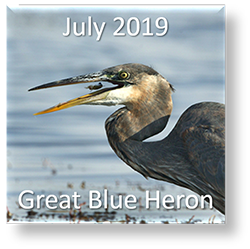 great blue heron Ardea herodias
great blue heron Ardea herodias
What is a Great Blue Heron?
A great blue heron is a type of bird. Birds are warm-blooded animals with feathers, hard-shelled eggs and lightweight bones. Because they are warm-blooded, birds can maintain a constant internal body temperature and be active when their natural environment has extremes of very warm or very cold conditions. Feathers are used for flight, protection and attraction of a mate. They also aid in controlling body temperature and in helping birds identify other birds. Birds lay hard-shelled eggs. The hard shell, made mostly of calcium carbonate, keeps the egg from drying out and allows parents to sit on the eggs during incubation. Lightweight bones are necessary for flight. Bird bones are strong and have internal braces. Many bird bones are filled with air and are connected to the respiratory system. Other bones are fused together, increasing their strength.
What Does It Look Like?
Herons are wading birds that have a long neck and a thick, pointed beak. The great blue heron has blue‐gray body feathers with white coloring near its head and neck. The yellow‐green legs are long and skinny. The male and female great blue herons are similar in appearance.
How Big is It?
At 42 to 52 inches in length (bill tip to tail tip in preserved specimen), the great blue heron is the largest heron in Illinois. The adult stands at about four feet tall. Its wingspan is about six feet.
Where Does It Live?
The great blue heron is a common migrant through Illinois and a summer resident in Illinois. It winters
from the southern United States to South America. However, if the winter weather is warm enough, some great blue herons stay in the state during winter especially in southern Illinois. This species lives in marshes, ponds, lakes, flooded fields, swamps and along the shorelines of rivers.
How Does It Reproduce?
These birds nest from March through May, usually with other herons in tree colonies called rookeries.
The nest is a platform of large sticks arranged in a tall tree. Three to six blue‐green eggs are laid. Birds
disperse to the north after nesting.
What Does It Eat?
The great blue heron feeds mostly on fishes, insects and crayfish. It will also take frogs, salamanders, turtles, snakes, small rodents and small birds, especially ducklings and shorebirds. Great blue herons have been known to hunt for and eat voles and gophers in fields.
Does Anything Eat It?
Because they are so large, great blue heron adults are not preyed upon by many animals except bobcats (Lynx rufus) and coyotes (Canis latrans). However, young birds at the nest are often eaten by hawks and bald eagles (Haliaeetus leucocephalus). Eggs are also eaten by hawks, vultures, eagles, crows and gulls.
What Else Should I Know About It?
It has a low call of "frahnk, frawnk, frawnk."
Like the other herons, its neck is held in an "S" formation during flight with its legs trailing straight out behind its body.
This species migrates by day or night, alone or in flocks. Spring migrants begin appearing in Illinois in February.
This bird hunts mainly by standing still or walking slowly in shallow water waiting for a prey item to swim by. It catches prey in its beak. It may hunt during the day or at night.

